Options trading has its own unique terminology that may seem complex to beginners. However, understanding key options terms is essential for actively trading options and implementing strategies successfully. This guide will explain 22 common options trading concepts covering the basics of calls, puts, volatility, pricing models, options Greeks, and trading approaches.
Learning options lingo empowers traders to communicate more effectively, enhance trading skills, and boost profitability. Comprehending key terminology is invaluable for traders to interpret options pricing, manage risks, evaluate strategies, and ultimately boost profitability in their options trading endeavors.
Options trading has its own unique set of terminology covering concepts like volatility, premium pricing, order types, profit potential, expiration impacts, and trading strategies. Key terms include standard deviation as a measure of underlying price fluctuation; exercise which converts contracts into assets; change that quantifies daily premium differences; volume indicating traded quantities; short for selling to open positions; volatility representing uncertainty; assignment allocating exercised contracts; long for purchasing contracts; bid prices showing buyer demand; ask prices depicting seller supply.
Also last traded prices showing recent valuations; intrinsic value as inherent profit; expiration dates dictating maturity; strike prices defining cost; open interest or positions outstanding; time value as potential beyond intrinsic; contract names identifying trades; stop-loss orders protecting against loss; in-the-money meaning profitable; out-of-the-money indicating no profit; at-the-money representing breakeven; and the difference between index options on entire markets and equity options on individual stocks. Understanding this vocabulary is crucial for effective options analysis, strategy selection, risk management, and ultimately trading success.
1. Standard Deviation
Standard deviation is a measure that indicates the dispersion of returns from the mean or average return, providing a quantification of volatility. It measures the variation or dispersion of price points from the mean, indicating how closely or loosely the price data is clustered. You interpret a low standard deviation to mean that the data points closely adhere to the mean, while a high standard deviation points to a wider spread of data from the average.
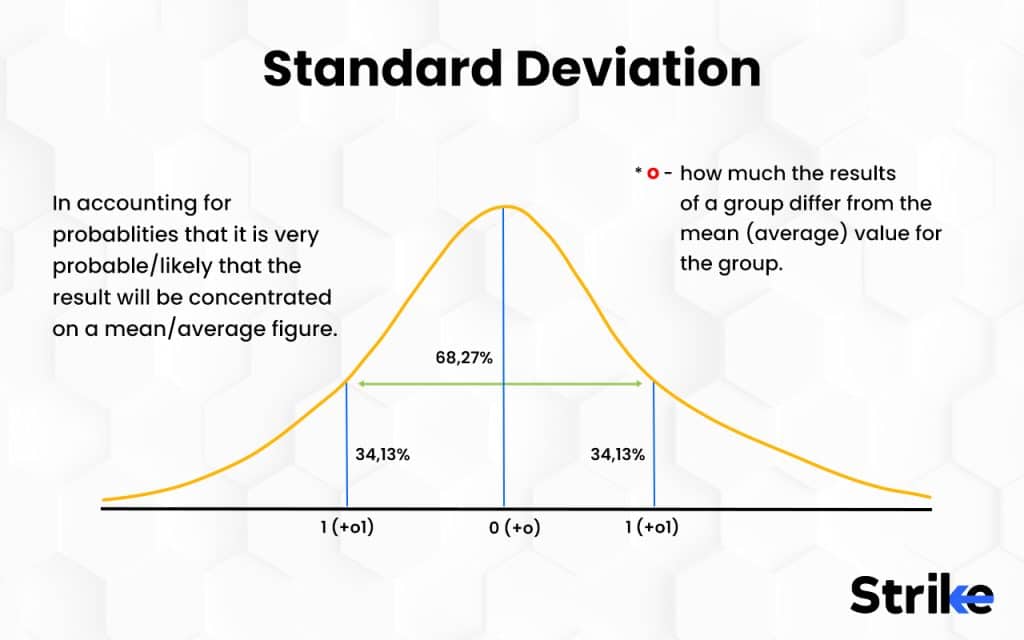
The application of standard deviation in options trading is to measure the yearly volatility of the underlying asset’s price. For instance, a standard deviation annualized at 25% indicates that the asset price fluctuates within a range of 25% above or below the mean return each year. Traders find usefulness in standard deviation as it allows them to gauge the asset’s volatility and tendencies of price fluctuation.
The ability to estimate the probability of future price moves based on historical volatility is another benefit of standard deviation. With the use of the volatility level or standard deviation, traders plot probability distributions, forecasting the likelihood of various price outcomes.
Standard deviation is a tool that allows estimating the range within which prices have a 68% (one deviation), 95% (two deviations) or 99% (three deviations) chance of happening. Such probabilistic analysis is utilized by traders to identify options that may be mispriced. Mispricings are often signalled when the implied volatility or standard deviation priced into the option significantly diverges from the historical standard deviation.
The comparison of the historical standard deviation to current implied volatility is a method traders use to spot options that may be overpriced or underpriced. Implied volatility is derived from an option’s price and represents the market’s estimate of future volatility. Situations, where the historical standard deviation is lower than implied volatility, suggest that options are overvalued due to overestimations of volatility.
Options could be undervalued based on volatility expectations if the standard deviation is higher than implied volatility. Comparing these two metrics guides informed trades, enabling profit from volatility skews and option mispricings. Standard deviation works in tandem with Greek metrics like Vega to construct volatility-based trading strategies.
An example of this in action is seen with Nifty options traded on the National Stock Exchange. Let’s assume the Nifty index has a historical standard deviation of 18%, calculated over the past 3 years, and 1-month Nifty call options are trading at an implied volatility of 22%. In this case, the implied volatility goes beyond the historical standard deviation, suggesting potential overvaluation.
Traders may employ a volatility arbitrage trade strategy to capitalize on this, selling the 1-month calls and hedging by buying further dated calls with lower implied volatility closer to the standard deviation. Implied volatility declining towards historical norms means the price differential net a volatility arbitrage profit.
But, on the other hand, if the 1-month standard deviation stood at 25% against an implied volatility of 18%, the reverse trade of buying near-term calls and selling longer-dated calls would be logical, potentially benefiting from an increase in volatility.
2. Exercise
Exercise refers to the process where the holder of an options contract converts their right to buy or sell the underlying asset into actually doing so. For call options, exercise means buying the underlying at the strike price to capture arbitrage profit. Put options, involve selling the underlying at the strike to pocket the difference versus the spot price.
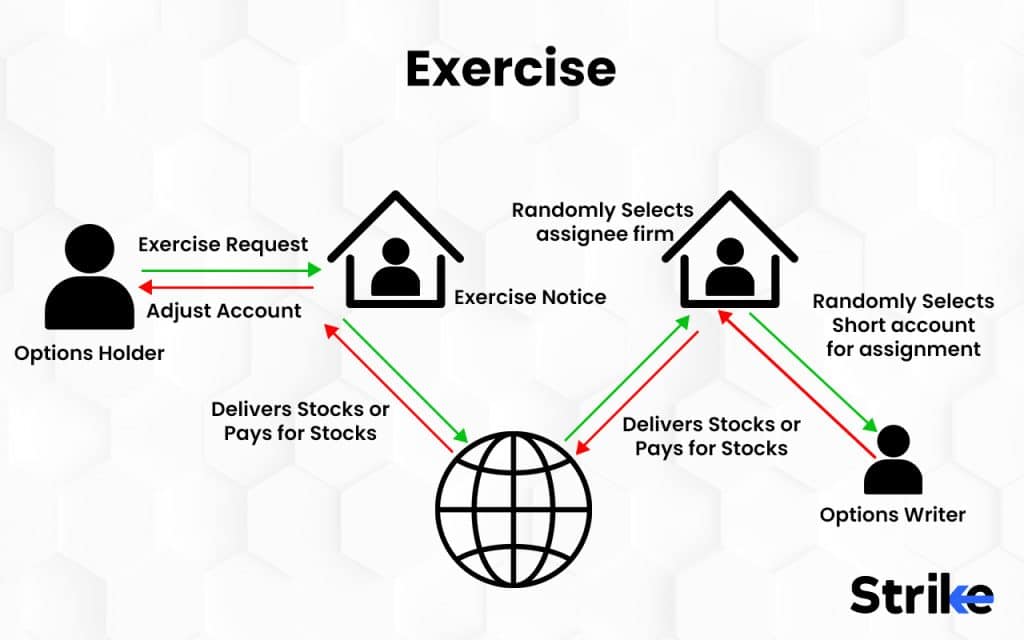
Exercise converts the notional options contract into really acquiring or disposing of the underlying stock, futures contract, index etc. as applicable. The option holder contacts the broker to exercise their right before or on the expiration date. Exercise means taking action to realize the intrinsic value built into profitable in-the-money options.
Options are exercised to capture riskless arbitrage profit from the divergence between the underlying price and strike price. A call option has a strike of Rs.100 while the stock trades at Rs.110 means exercising the call and immediately selling the stock in the market nets Rs.10 profit per share.
Similarly, exercising a Rs.100 put when the stock declines to Rs.90 gains Rs.10 per share. By exercising, option holders convert favourable intrinsic value into realizable profits. Brokers typically auto-exercise options if expiry in the money to protect client profits.
Investors exercise long calls and put option purchases on expiry to profit from the price difference versus the strike. Covered call sellers may face assignment on expiry if the stock closes above the short call strike, requiring them to sell their stock to the call buyer. Covered puts see a similar assignment if the price drops below the short put strike on expiry.
For American-style options, early exercise is permitted anytime before expiration. This is rarely optimal given extrinsic time value and transaction costs. Exceptions include deep in-the-money options, upcoming dividends, mergers etc. where early exercise improves payoff.
Consider buying a one-month Nifty call option with strike 12,000 when the Nifty 50 index trades at 11,800. As expiry approaches, if Nifty rallies to 12,100, the call option will have Rs.100 of intrinsic value and minimal time value. The investor then exercises the right to buy Nifty futures at Rs.12,000 and immediately sell at Rs.12,100 in the futures market to pocket a risk-free profit of Rs.100 per lot.
The Nifty falling to 11,600 by expiry means the call option will expire worthless. The buyer avoids exercising a call out-of-the-money on expiry which has no intrinsic value. Loss is restricted to the initial call premium paid.
3. Change
The term ‘change’ refers to the difference between the current market price of an option contract and the previous day’s closing price. The change indicates the movement or fluctuation in the option premium based on buying and selling activity. Change measures the uptick or downtick in the option’s value from one trading session to the next.
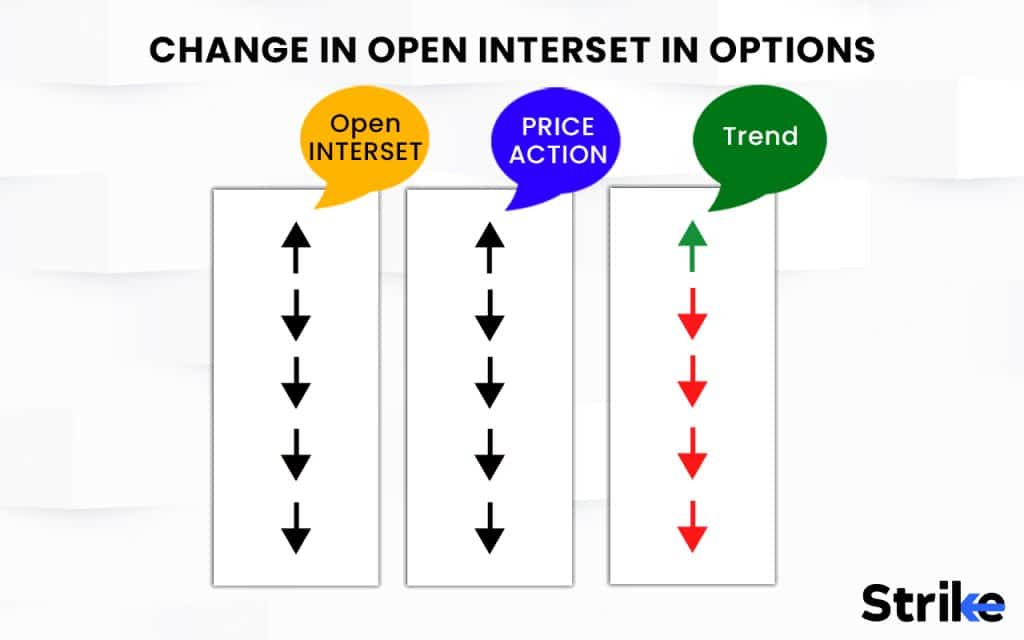
Change simply quantifies the rupee or percentage shift in the option premium over 1 day. Option prices are dynamic and change every moment based on underlying asset fluctuations, market events, and supply-demand forces driving trades. Change provides important insights into intraday and day-to-day price trends.
Traders analyze the change to identify noteworthy single-day movements in option prices and premiums. A significant overnight change signals a potential price trend, volatility shift or reaction to news events. Upside change indicates rising premiums while downside change points to declines based on emerging market sentiments.
Change is interpreted relative to factors like underlying asset fluctuations, time to expiry, upcoming events, and supply-demand dynamics unique to the contract. Large changes also impact trading decisions and strategy adjustments to capitalize on or hedge such movements.
Traders utilize change to optimize execution timing and capture intraday mispricing. For instance, a big upside change creates an opportunity to write options at inflated premiums. Outsized downside change prompts bottom fishing long call and put options at discounted rates after a correction.
The change also guides hedging decisions and rollover choices on expiring contracts. Significant downside change near expiry could signal early unwinding of short options to lock gains. Meanwhile, upside change may necessitate early rollover to farther-dated contracts to ride positive momentum.
Consider Bank Nifty put options expiring in 10 days trading at a premium of Rs.150. Overnight, due to negative news, the Bank Nifty index fell 3% triggering a surge in put option demand. The next day, the put premium opens higher by Rs.50 at Rs.200 i.e. a 33% upside change.
This substantial upside change creates a selling opportunity to short the puts at inflated prices. The trader sells the puts at Rs.200 to capitalize on the anticipated volatility cool-off and option value reversal from the knee-jerk-up move. The target is to close the short position near the original Rs.150 premium over the remaining expiry period.
4. Volume
Trading volume indicates the total number of option contracts that exchanged hands in a given period. Trading volume denotes the overall quantity bought and sold by market participants for a specific strike price or expiry date. Volume quantifies liquidity – the ease of entering and exiting option trades seamlessly. High-volume options have tight bid-ask spreads and are traded in size without significant slippage or price impact.
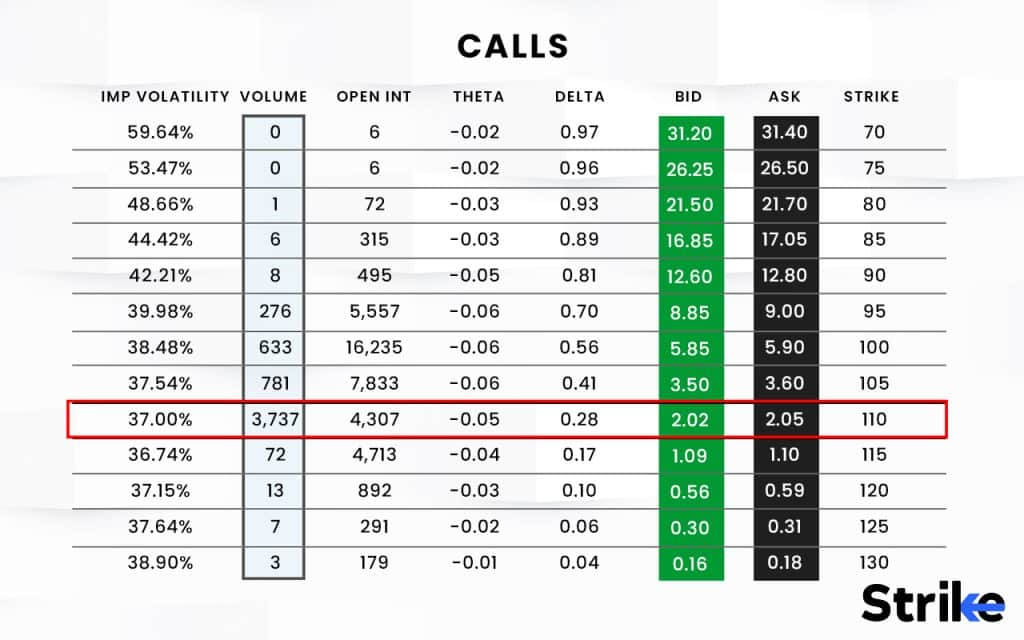
Intraday volume data reveals trading activity at periodic intervals within a day. Daily or monthly volume aggregates the cumulative number of contracts transacted in the entire trading session or month respectively. Volume analysis provides insights into buying and selling interest.
Volume analysis is crucial for assessing liquidity, gauging market interest, and informing trade sizing decisions. Active options with sizeable volumes provide flexibility for traders to enter and exit positions swiftly without influencing prices adversely. Lower volume contracts must be traded cautiously in smaller batches to minimize slippage.
Sudden surges in options volume highlight increased activity and urgency among buyers or sellers. This often signals a strong directional trend or volatility event. Volume changes also help validate breakouts and spot reversals during technical analysis.
Traders scan the option chain – a matrix of available strikes and expiries – to identify high-volume options for trade consideration. The most active options match market consensus and attract sufficient interest for better fills. Volume metrics also guide strategies like block trades, risk reversals and volatility arbitrage that benefit from high liquidity.
Consider daily options volume on the National Stock Exchange for the Nifty Index around major events:
- Regular day: 100,000 Nifty 10000 call contracts traded
- Pre-Earnings: 300,000 Nifty 10000 call contracts traded
- Budget day: 500,000 Nifty 10000 call contracts traded
Here the surge in volume signals elevated participation and directional bias among traders expecting an uptick in Nifty. Arbitrageurs sell the extremely liquid calls at high implied volatility to profit from the post-event volatility contraction.
5. Short
‘Short’ refers to the act of selling to open a new option position as opposed to buying to open. When traders short options, they are taking on the obligation to fulfil the terms of that options contract if assigned as the counterparty. Shorts collect premiums upfront by selling options but have upside risk if the market moves against them.
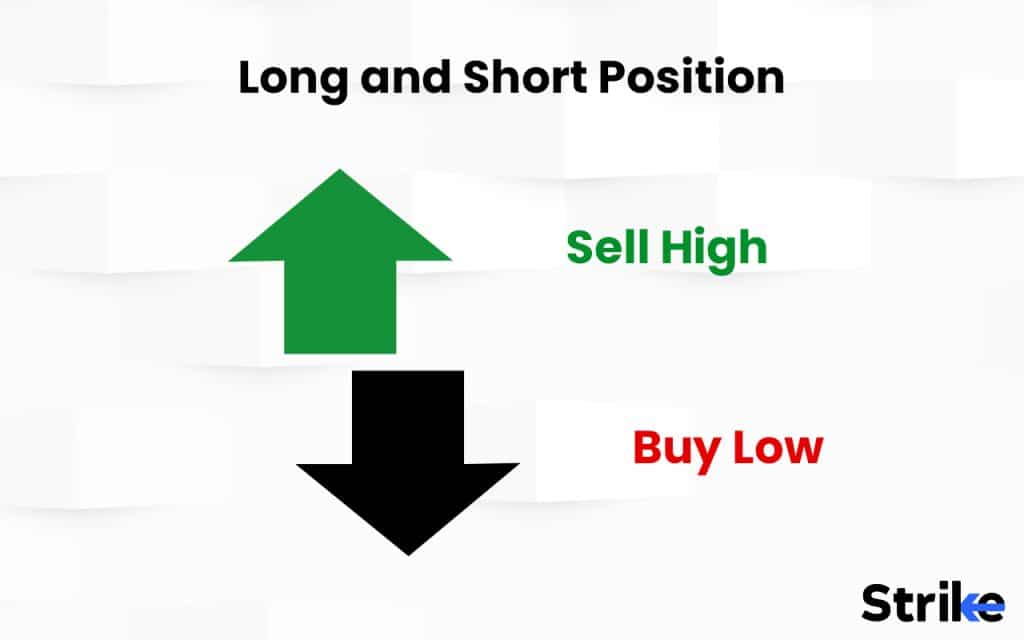
For call shorts, the obligation is to deliver the underlying asset at the strike price if assigned on expiry. For put shorts, it means buying the underlying at the strike if the short put is exercised by the holder at expiry. Shorts profit from time decay as options lose value heading into expiration.
Traders short options as a neutral to bullish income strategy, collecting premiums safely when the expectation is for muted market moves. The premium buffers the downside if the underlying declines moderately while providing profit if it trades rangebound. Shorts must be covered by holding/controlling the underlying asset to avoid unlimited risk.
Short options are also employed to hedge and offset risks in other positions. For example, owning stock creates downside risk mitigated by simultaneously shorting calls against it. Shorting adds income to offset a directional long position’s cost basis.
Short options strategies include naked and covered writing, bear spreads, ratio spreads and volatility arbitrage. Naked shorts involve higher risks and requirements. Covered shorts are popular on owned assets like stocks or futures to enhance yields. Spreads combine short and long options to define risk. Arbitrageurs short overvalued options and hedge accordingly.
An options trader cautious on Reliance Industries could sell 1500 put and 2000 call one-month strangle to profit from sideways or muted price action. The short put and call generate premium income, with profit potential between the strikes at expiry. The trade is hedged by maintaining sufficient margins to handle assignment risks on both sides.
6. Volatility
Volatility refers to the magnitude and frequency of fluctuations in the underlying asset’s price over a period of time. Volatility indicates the propensity for the price to make sharp up or down moves. Higher volatility points to wider daily price swings with frequent reversals. Lower volatility indicates muted, narrow ranges in asset prices.
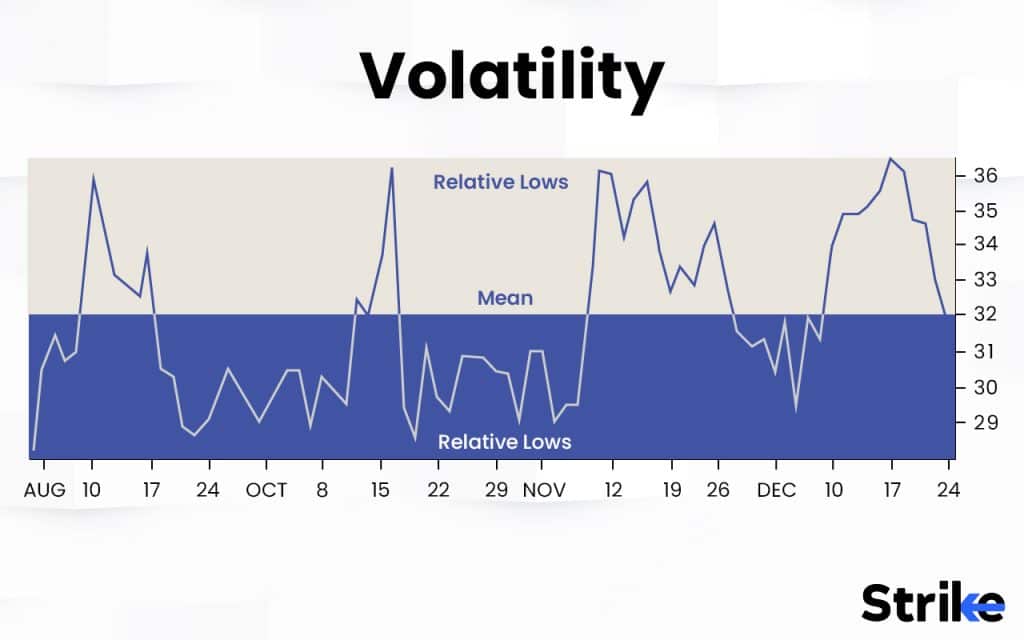
Volatility is a key factor governing the premiums of options contracts. Options gain value with rising volatility as the probabilities of favourable price moves increase. Volatility reflects the amount of uncertainty priced into options.
Traders analyze volatility measures like historical volatility and implied volatility to estimate the probable range of outcomes for the underlying asset price. The volatility level indicates how dispersed price changes could be. Higher volatility implies a wider array of outcomes, increasing the value of options for long holders. Volatility analysis enables gauging if options are underpriced or overpriced based on prevailing volatility assumptions. Traders capitalize by buying underpriced options or selling overpriced options to profit from volatility movements.
Volatility analysis has widespread applications from forecasting to volatility trading, hedging, risk management and structuring of options spreads. Traders employ long or short volatility strategies to capitalize on expansion or contraction in volatility. Portfolio hedges are structured using options that gain value as volatility rises to offset risks.
Crude oil experiences frequent price spikes and heightened volatility during events like supply disruptions, OPEC meetings etc. Traders capitalize using options that benefit from volatility expansion. One strategy is to buy low volatility crude oil call options in anticipation of a surge in volatility. When a volatility-boosting event occurs, the calls gain value from heightened uncertainty, generating trading gains. Options like crude with cyclical volatility patterns offer regular volatility trading opportunities.
7. Assignment
Assignment refers to the process by which the Options Clearing Corporation (OCC) allocates exercised options contracts to options sellers to fulfill their obligations. The OCC randomly assigns the contract to an active seller who then must carry out the required action to facilitate settlement when the option holder exercises their right.
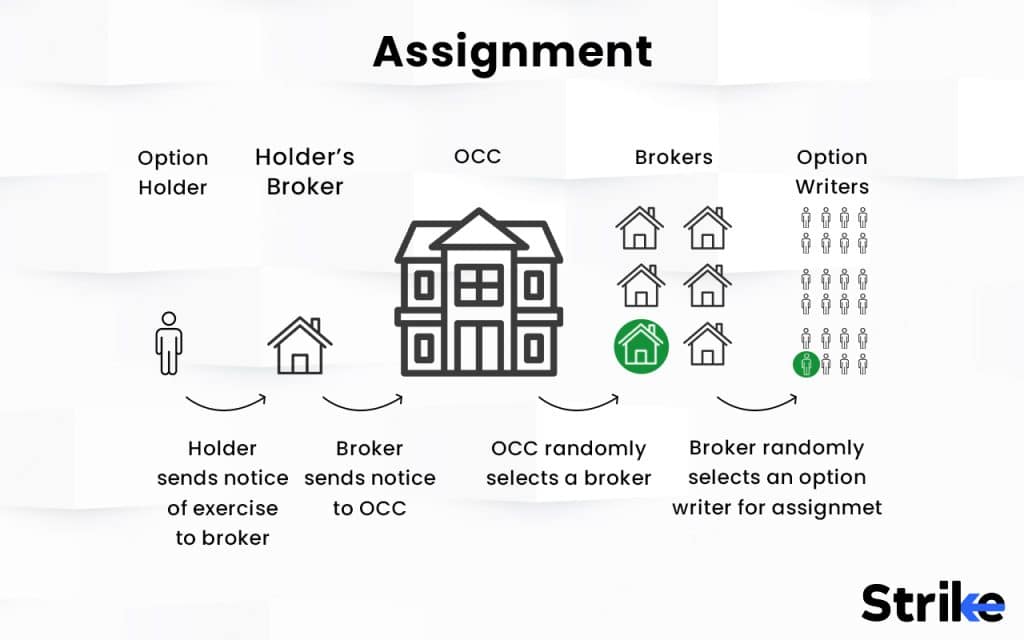
Assignment obligates the short call seller to deliver the underlying asset to the exercising call buyer for call options The assigned call writer must provide the asset to the OCC to be transferred to the call owner. For put options, assignment requires the short put seller to immediately buy the underlying asset from the exercising put owner at the strike price to complete the settlement.
Assignment occurs when in-the-money options are exercised by long holders near or on the expiration day. The OCC randomly allocates exercised contracts to sellers creating an obligation for them to take the necessary action. Call assignment requires delivery of the underlying to the OCC while put assignment means purchase of the asset.
This process facilitates the settlement obligations when options are exercised for profit. The OCC assigns sellers and the resulting transactions convert the options into the underlying asset or cash settlement value for the long holder at expiry.
Assignment risk is faced by naked and covered call/put sellers. Covered call writers risk losing their underlying stock if assigned on short calls. Covered put sellers must purchase additional stock if the assignment happens on the short puts. Naked call and put sellers face unlimited risks if the open shorts are exercised. Consider a trader who sells Nifty put options at 12000 strike when the index trades at 12500.
At expiry, if the Nifty falls to 11800 and the 12000 puts are exercised by buyers, the trader faces assignment risk. The OCC will randomly allocate exercised puts to active put sellers. The trader will have to fulfill the obligation by buying Nifty at Rs.12000 from put owners and incurring a loss of Rs.200 per Nifty lot. Using assignment logic optimally and planning exit strategies around expiry is crucial for short options sellers.
8. Long
Going long in options trading means buying or holding the call or put options with the expectation that the value of the underlying asset will move favourably before the option’s expiration. A long position profits if the option premium rises from the initial purchase price.
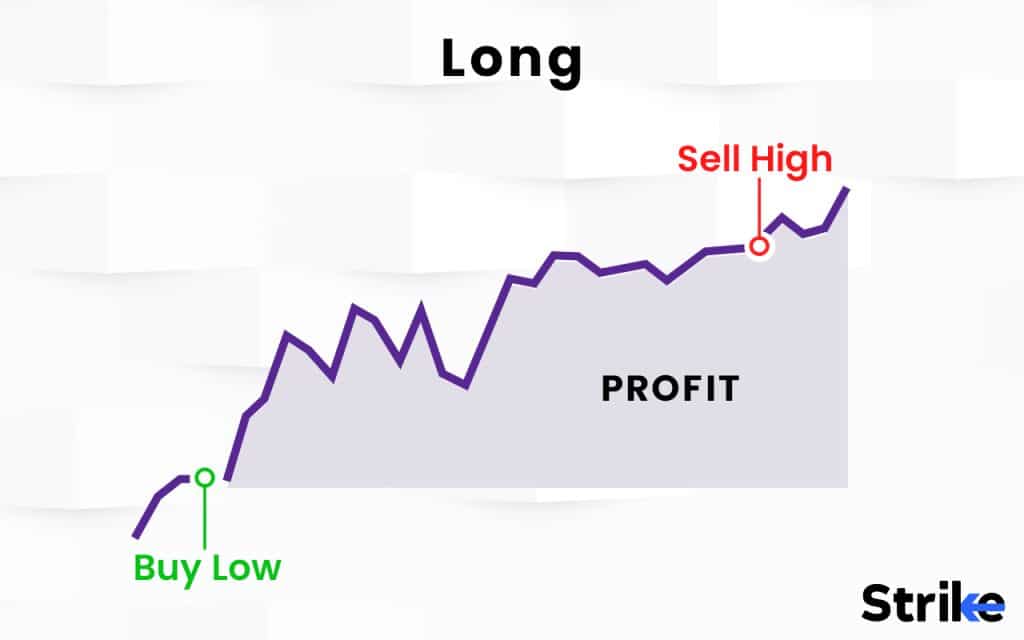
It is important to note that options are a complex financial instrument and should only be used by experienced investors who understand the risks involved.
Traders assess factors like implied volatility, time to expiration, strike selection and liquidity to target optimal entry points. Actively managing longs involves adjusting strikes or rolling contracts to continue benefiting from ongoing momentum.
A trader may go long Infosys call options if anticipating strong IT spending and upside ahead of quarterly earnings. In the case where the announcement exceeds expectations and Infosys share price rallies, the long calls become increasingly profitable. The trader can sell at higher premiums to realize gains.
9. Bid
The bid price represents the highest price a buyer is willing to pay for an options contract. Along with the asking price, the bid is a key component of the live quotes provided for options markets. The bid indicates the maximum price a buyer will pay at the current time to open a long position in a call or put option. It sets the demand-side limit in the ongoing price discovery process between interested buyers and sellers of a particular options contract.
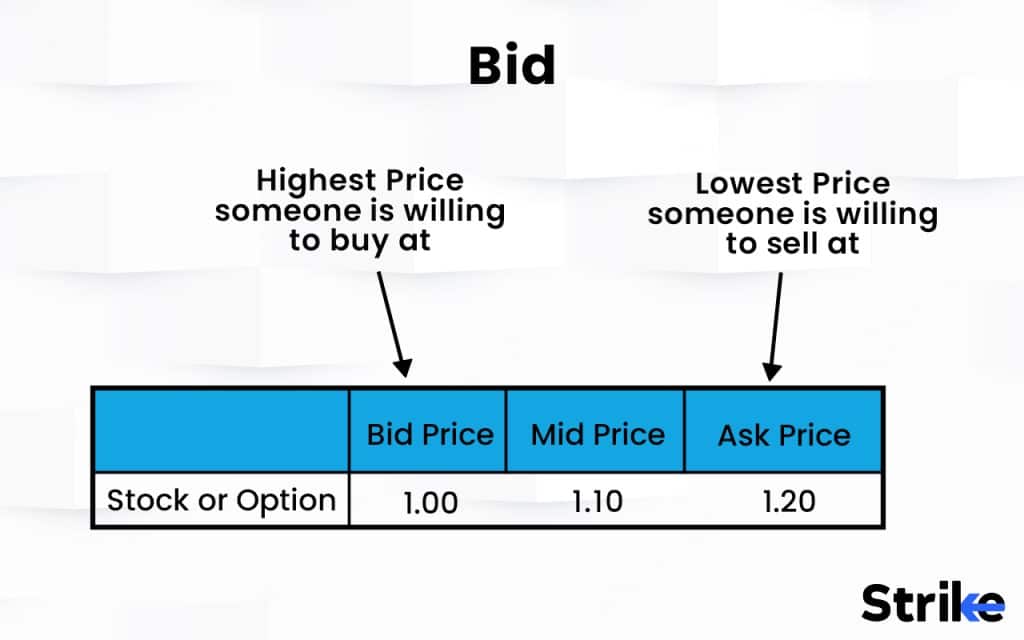
On an exchange like NSE or BSE, the bid is the highest limit order on the buy side – meaning the highest unexecuted order to buy waiting in the order book. It represents the best potential price for options sellers looking to open new short positions. Active options traders monitor the relative levels of current bids versus the market price and ask for quotes. A higher bid signals increased buying interest, especially if it rises relative to the last traded price. Weakening bid levels warns of waning demand.
Changes in the bid price occur based on shifting supply and demand dynamics and evolving expectations of buyers and sellers. Buyers may raise their bids if anticipate favorable moves in the underlying asset before expiration. Bids decline when buyers become less willing to pay higher premiums due to negative outlooks.
Traders apply strategies to buying options based on bid pricing. The bid at or below fair value is estimated by pricing models to maximize the odds of getting filled. Start bidding below theoretical value, then increase the bid if needed. Be patient for better entries. Consider lifting bids when volatility drops or positive news emerges on the underlying. Refrain from chasing asks higher unless strongly bullish – allow sellers to concede instead.
For example, consider the current bid-ask quote for Reliance 2400 call options is Rs 75 – Rs 80, a trader bids at Rs 77 to maximize chances of entering a long call position at a favourable price. The trader’s order would execute if an interested seller transacts at Rs 77 or drops their ask price to match the bid.
10. Ask
The ask price, also known as the offer price, is the lowest price a seller is willing to accept for an options contract in the derivatives market. Along with the bid price, the ask price is a key component of the options trading process.
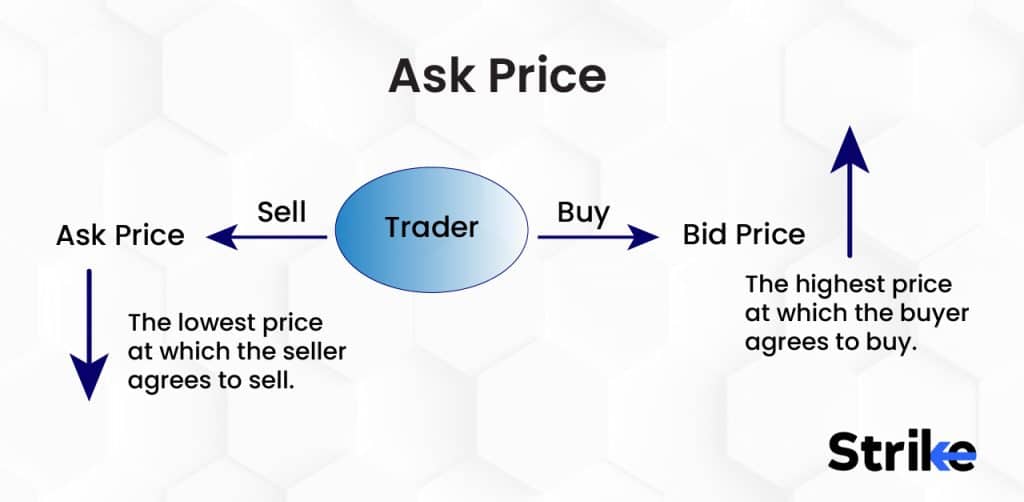
An investor who wants to sell an options contract will ask for their minimum acceptable price. For example, consider shares of HDFC Bank (HDFCBANK) are trading at Rs 1,500. Then an investor may ask for Rs 125 to sell an HDFCBANK Rs 1,600 call option expiring in two months. This means the seller will only part with the call option if they receive a premium of at least Rs 125. The asking price reflects the minimum compensation required by the seller for taking on the obligation to potentially sell shares to the buyer.
A higher ask price indicates the seller requires more return potential to accept the risk of the trade. For call options, a higher ask price suggests the seller expects the underlying price is unlikely to rise significantly. For put options, it signals a seller’s view that a sharp decline is improbable.
The seller will want to set the ask price high enough to make a profit, but not so high that no one is willing to buy the option. The closer the option is to expiration, the less time there is for the stock price to move in the seller’s favour, so the seller will likely set a lower ask price. Implied volatility is a measure of how much the stock price is expected to move.
The higher the implied volatility, the more likely the stock price is to move in the seller’s favour, so the seller will likely set a higher ask price. Interest rates affect the value of options, so the seller will need to take them into account when setting the ask price. The seller will need to subtract the value of the dividends from the ask price If the stock pays dividends.
A common asking strategy is to start with a high price first and then gradually lower the ask if needed until there is a buyer willing to meet it. The seller aims to sell the options contract at the highest premium possible while still having their order filled in a reasonable timeframe.
The asking and bidding processes lead to the discovery of the market price for an option. On electronic trading platforms like those offered by NSE and BSE, the ask price displayed for an option contract represents the lowest offer among all sellers in the market. A trade occurs when a buyer’s bid price matches or exceeds this ask price.
For example, a trader in India looking to speculate on Infosys (INFY) shares may ask for Rs 75 to sell an INFY Rs 1,400 put option expiring in 6 months. In case a buyer bids Rs 80 for this contract, the trade is executed at Rs 80. The seller collects this Rs 80 premium in exchange for the obligation to buy INFY shares at Rs 1,400 if assigned. The seller gets to keep the premium as profit INFY stays above Rs 1,400.
11. Last
The last price represents the most recent price at which an options contract traded. The last price is continuously updated throughout the trading day whenever a buy and sell order is matched for a particular contract. Along with related metrics like bid, ask, and volume, the last price is a core data point tracked closely by options traders. The last trade price reflects the agreed-upon amount between an options buyer and seller in their most recent transaction.
The last price fluctuates frequently over the course of a trading session in response to shifting buyer and seller expectations. For very liquid options contracts on major stocks or indices, the last price changes multiple times per minute. Less active options may only have sporadic trading, leading to infrequent updates to the last traded price.
Options traders closely monitor the last price in relation to the current bid and ask prices. A lower list price compared to the ask means a seller recently conceded on price in order to find a buyer. A higher last versus the current bid indicates a buyer was aggressively willing to pay up to secure a contract. Comparing the current market quotes and the last traded price helps gauge buyer and seller sentiment.
The simplicity of the last price also makes it a useful baseline for evaluating an option’s theoretical value. Traders often utilize options pricing models to calculate a ‘fair value price based on metrics like implied volatility and time to expiration. The current last traded price is significantly higher than the estimated model value signals the option is overvalued. Conversely, the last is well below fair value represents an undervalued trading opportunity.
The last price is also critical for tracking profit and loss on an existing options position. For options bought and sold at different prices, traders determine their unrealized P&L by comparing the original entry price to the current market value as given by the last traded price. As the last price fluctuates, it provides ongoing updates on how an options trade is performing.
For example, say a trader in India buys an ICICI Bank Rs 500 call option for a last price of Rs 35. Consider ICICI subsequently rallies and the last on this call option climbs to Rs 60, and the trader has an unrealized profit of Rs 25 per share. The trader continue to hold the option and hope for additional gains or lock in profits by selling at the current Rs 60 last price.
12. Intrinsic Value
Intrinsic value represents the built-in value of an option contract based solely on its current relation to the strike price and market price of the underlying asset. Intrinsic value is the portion of an option’s premium that is not eroded by time value decay. For in-the-money options, intrinsic value forms the minimum value and acts as a price floor.
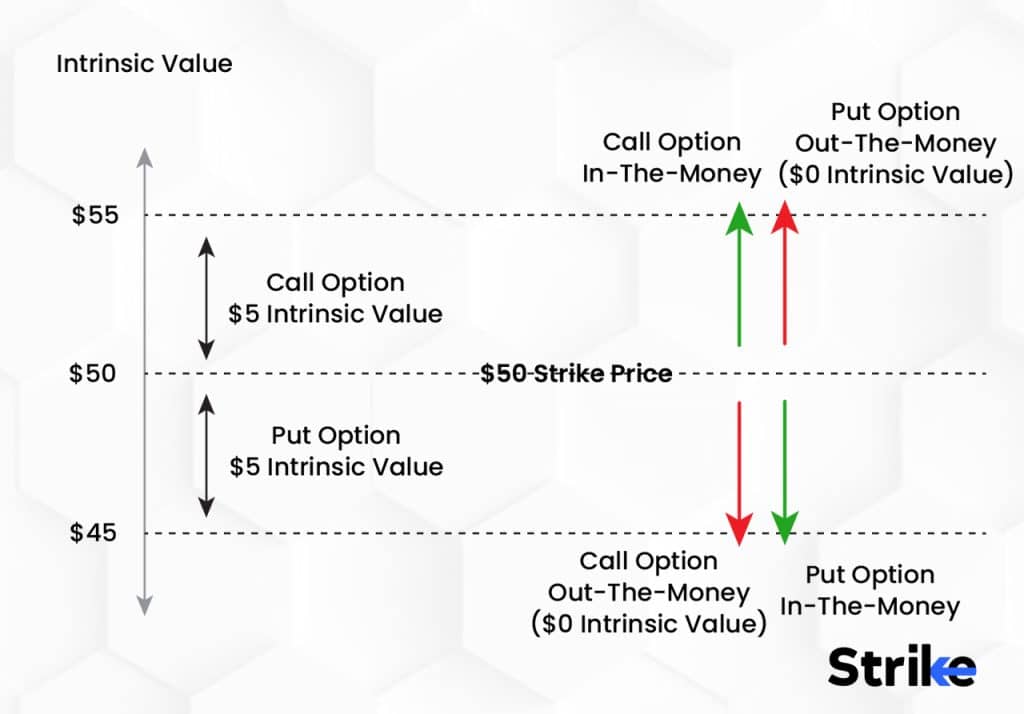
The intrinsic value of a call option is the amount by which the current market price of the underlying exceeds the strike price. For put options, it is the amount by which the strike price exceeds the current market price. Intrinsic value only applies to and increases for in-the-money options. Both at-the-money and out-of-the-money options have zero intrinsic value.
For example, consider a Wipro call option with a strike price of Rs500 when Wipro is trading at Rs550. This option has Rs50 of intrinsic value per share because the right to buy Wipro at Rs500 is inherently worth Rs50 when shares can immediately be sold at Rs550. Wipro falling to Rs450 means the same call option now has zero intrinsic value.
Intrinsic value sets the lower bound for an option’s market value. Time value or extrinsic value is then added on top to reach the full premium. Deep-in-the-money options derive most of their premium from intrinsic value, while most of the price of at or out-of-the-money options comes from time value alone.
Traders calculate the intrinsic value to gauge how much of the current market price comes from a basic inherent value versus expectations-driven extrinsic factors. Comparing intrinsic value to the market premium helps identify potentially overvalued or undervalued options. Understanding the makeup of option prices in terms of intrinsic and extrinsic components is key for informed trading.
Monitoring intrinsic value is also essential around an option’s expiration. As time value decays, the intrinsic value becomes the dominant factor in the remaining premium. On expiration day, time value drops to zero and only the intrinsic value remains for in-the-money options. This helps traders evaluate final exercise and settlement decisions near expiration dates.
For certain advanced options strategies like spreads, the maximum possible profit is equal to the difference between the intrinsic values of the long and short legs. Therefore, estimating the intrinsic value of the underlying components provides guidance on the overall profit potential.
Traders look at intrinsic value when trading options on stocks like Reliance, Infosys or Tata Motors. For example, say a trader holds Tata Motors Rs 400 put options while the stock trades at Rs 380. With the shares Rs 20 below the strike price, the puts have accrued Rs 20 of intrinsic value per share. This intrinsic component remains constant and supports the puts’ premium regardless of time value erosion going forward.
13. Expiration Date
The expiration date is the precise date on which an options contract expires and ceases to exist. Till the expiration date, the buyer of the option has the right to exercise their contract based on the agreed upon terms. Once the expiration date is reached, the contract immediately becomes worthless and all rights and obligations under the contract are extinguished.
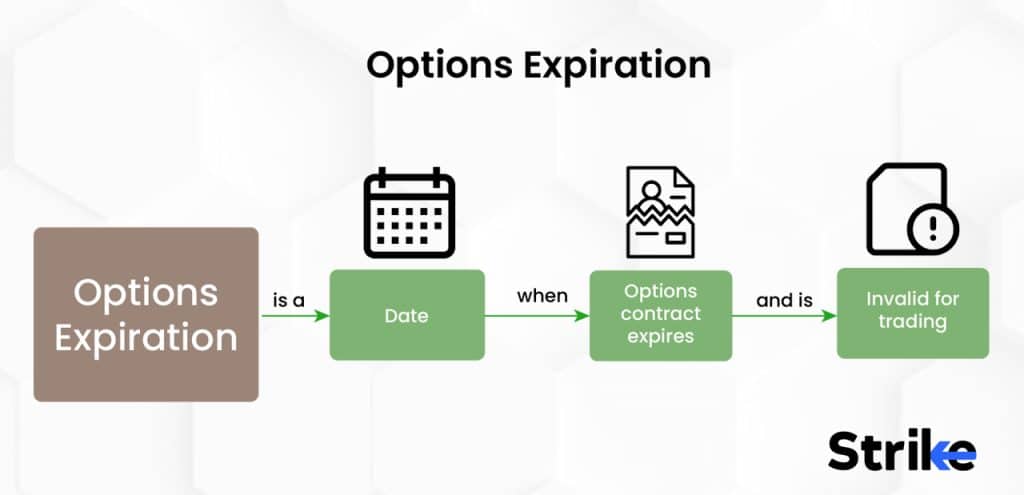
All options contracts have a defined expiration cycle determined by the options exchange they are created on. For example, the National Stock Exchange of India offers monthly expiration cycles for stock options, while index options expire on the last Thursday of the contract month. Expiration dates typically fall on the third Friday of each month in U.S. options markets.
The timeframe until the expiration date directly impacts the value and pricing of an option. Options with longer duration until expiration have more time value built into their premium. This time value represents the probability of the option becoming profitable as market conditions change over the remaining life of the contract. Options expiring very soon will have little to no time value left.
As the expiration date approaches, time value decay accelerates and the rate of decline in the option’s premium increases. This erosion of extrinsic value is known as theta decay and proceeds exponentially in the last 30 days or less until final expiration. Traders closely monitor an option’s time to expiration and make strategic decisions based on their outlook and goals before the definitive expiration date. Common choices leading up to expiration include the following.
- Exercise the option to acquire shares if the stock price rises above the strike price.
- Exercise the put option to sell shares at the favourable strike price if the stock falls below it.
- Sell the option to collect the remaining time value premium before expiration.
- Allow the option to expire worthless if it is out of the money.
- Roll over the option by closing the position and opening a new one with a later expiration.
- Use various spread strategies to hedge exposure at expiration.
Expiration dates introduce urgency into options trading. Traders seek to maximize profits or minimize losses in a defined period knowing the contract’s lifetime ends decisively on a single, predetermined date.
For example, say a trader in India purchases a one-month Reliance Rs 2000 call option on January 1st with an expiration of January 31st. Reliance stock is trading for Rs 2,100 on January 15th, and the trader chooses to exercise the option early to capture the Rs 100 per share profit. Alternatively, the stock is at Rs 1900 on January 30th, and the trader faces expiration the next day and will likely allow the option to expire worthless.
14. Strike Price
The strike price, also known as the exercise price, is the fixed price at which the owner of an options contract buy or sell the underlying asset. The strike price is a key variable in options trading and is set at the time the contract is created. The strike price represents the purchase price for buyers if they choose to exercise their right to buy the underlying stock or asset. For put options, it is the sale price for sellers if they exercise their right to sell the underlying. Each option contract locks in one strike price which remains constant up until expiration.
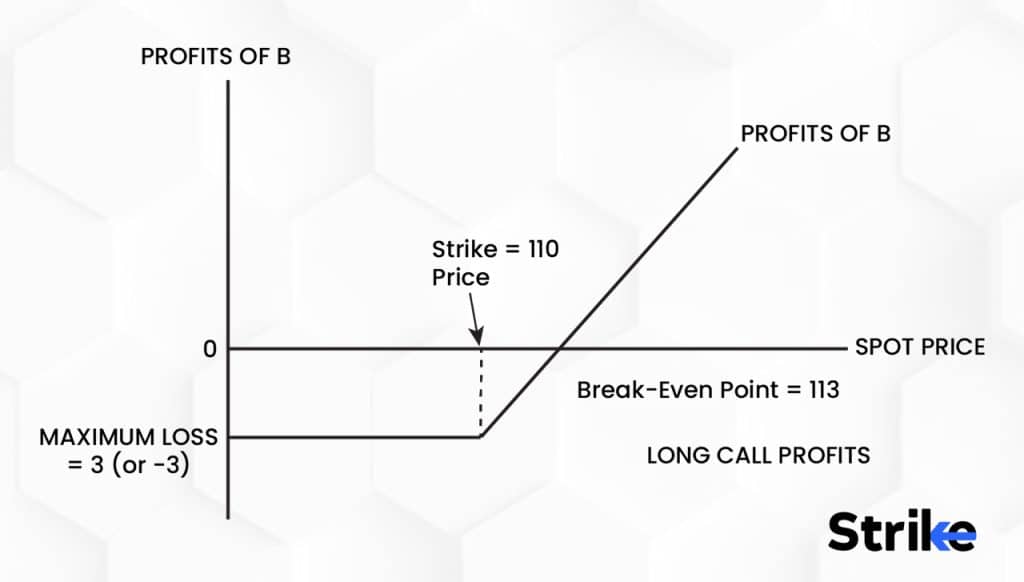
Strike prices are set at various incremental levels based on the current market value of the underlying. Common strike interval sizes include $1, $2.50, $5 and $10. The ‘at-the-money’ strike price usually aligns closely with the current trading price. ‘In-the-money’ strike prices are below current value for calls and above for puts. ‘Out-of-the-money’ strikes are above and below respectively.
Buyers and sellers weigh factors like their risk tolerance, price forecast, and breakeven considerations. Traders also assess how volatility, time to expiration, interest rates and other variables impact profitability at a given strike.
The relation of the strike price to the market price heavily influences the pricing models used to calculate an option’s theoretical value. Deep in- or out-of-the-money strike prices have higher extrinsic value from volatility components versus at-the-money strikes where intrinsic value dominates.
Monitoring the strike price is crucial leading up to expiration dates. Owners of in-the-money options choose to exercise contracts if share prices cross favourably over the strike. Unexercised, out-of-the-money options expire worthless if market prices remain beyond strike levels at expiration.
Traders implement various strategies to target optimal strike prices based on market conditions and risk profiles. For example, a long straddle involves buying an at-the-money call and put to benefit from sharp upside or downside moves. Spreads often combine long and short options at different strike prices to define maximum profits and losses. Traders actively trade index, equity and currency options with strikes tailored to domestic price levels.
For example, a trader bullish on HDFC Bank buy a slightly out-of-the-money Rs 1500 call option if shares are near Rs 1450, anticipating prices will rise beyond Rs 1500. An investor bearish on the Indian Rupee could buy dollar-rupee put options with a strike of Rs 75 to capitalize if the rupee falls from the current Rs 74 level against the dollar.
15. Open Interest
Open interest refers to the total number of outstanding derivative contracts, including options, that are held by market participants at the end of each trading day. Option interest is a measure of liquidity and activity in the options market. Open interest applies to both puts and calls on a given underlying asset and is reported on a daily basis by options exchanges. For each contract, open interest tells traders how many buyers and sellers currently hold open positions that have not yet been offset, closed or expired.
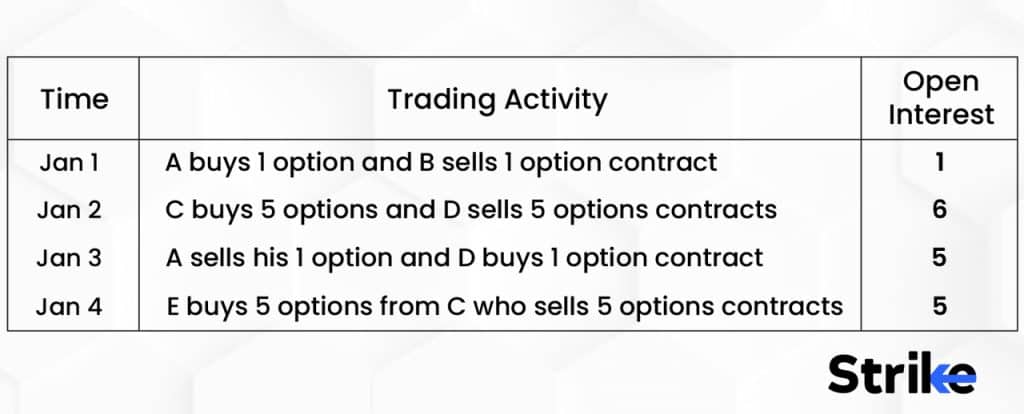
As options trading progresses during a session, open interest fluctuates in reaction to new opening and closing transactions. Open interest increases if new contracts are created because more traders are entering trades. Open interest declines accordingly when existing contracts are offset or closed out.
Options traders analyze open interest patterns to gauge sentiment and participation in the market. Rising open interest during an uptrend signals new buyers are entering call positions to capitalize on continued momentum. Declining open interest during a downtrend often reflects holders of put options taking profits or exiting losing trades.
The relation between open interest, volume and price action provides useful insights. For example, rising open interest alongside increasing volume points to fresh capital flowing into the market and new positions being opened. Falling open interest and volume indicates the majority are closing out positions and waiting on the sidelines. Traders also monitor open interest leading up to option expiration dates.
Open interest in front-month, near-term contracts will decline rapidly as expiration approaches, signalling traders closing out soon-to-expire positions. Open interest rolling to later months reflects traders positioning for an extended move by opening longer-dated contracts.
For example, say Infosys options have a current open interest of 50,000 contracts spread across calls and puts. On Monday, 5,000 new Infosys call options were bought while only 1,000 puts were sold. Tuesday’s open interest will rise to 54,000 reflecting the 4,000 contract net increase from Monday’s trading activity.
Traders closely track open interest on index and stock options like Nifty, Reliance, HDFC Bank and TCS to assess shifting sentiment and positioning in the market. Rising open interest in out-of-the-money Nifty calls, for example, indicates increased bullish bets on the index breaking out to new highs.
16. Time Value
Time value, also known as extrinsic value, is the portion of an option’s premium that is attributable to the amount of time remaining until expiration. Time value represents the extra value that a buyer is willing to pay for an option above its intrinsic value based on the probability it will become profitable over time.
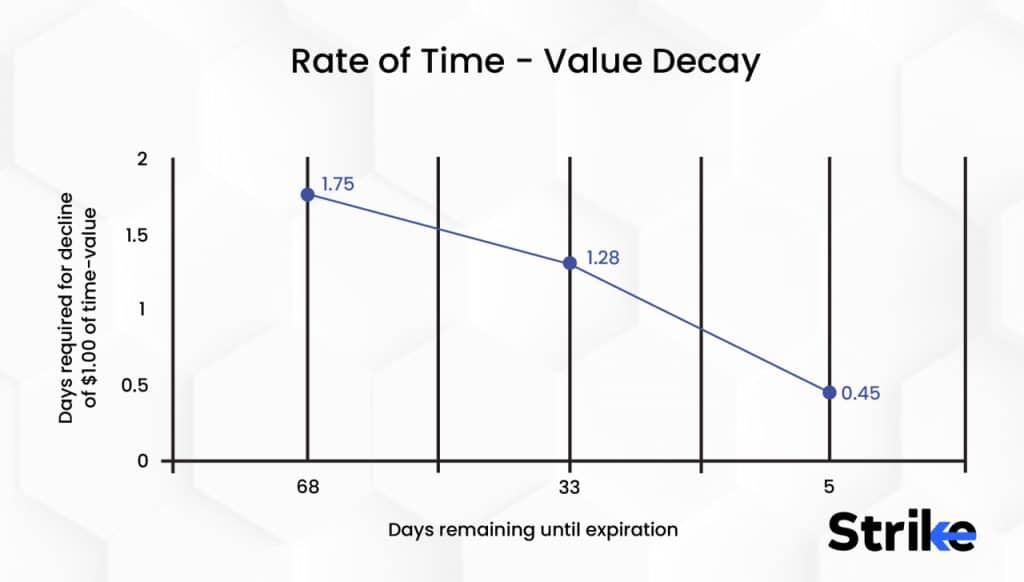
Intrinsic value only applies to in-the-money options, but all option contracts have some level of time value priced into the premium paid by option buyers. Time value decays over the life of the option, declining as maturity approaches. Deep out-of-the-money options derive almost all their value from time value alone as they have zero intrinsic value.
The key factors determining an option’s time value include the current underlying price, strike price, time to expiry, volatility, interest rates and dividends. Models like Black-Scholes calculate theoretical time values based on these variables. In general, longer duration options on more volatile underlying have higher time value premiums.
Traders look closely at time value when evaluating potential trades. Overpriced options with excessive time value relative to probable outcomes often present unfavourable risk-reward scenarios. Options with cheap time value can offer advantageous entry points before the market moves.
Monitoring time decay is also crucial for active options traders. As expiration approaches, the erosion of time value accelerates which impacts pricing and profits. Different strike prices also exhibit varying time value decay patterns. Strategies like call writing involve collecting time value premiums by selling options. Rolling options before expiration involve closing out soon-to-expire contracts that still retain some time value and opening later-dated ones. Spread trades carefully consider time value differentials between legs to define risk parameters.
For example, say a trader in India buys a one-month out-of-the-money Nifty put option with a premium of Rs 30. Most of this Rs 30 is time value, with the hope Nifty falls below the strike in the next month. Nifty remains flat means the put option will decay towards zero as expiry nears and time value erodes.
17. Contract Name
The contract name refers to the specific standardized name identifying an options contract listed on an exchange for trading. Understanding the format and information contained in an options contract name is crucial for effectively navigating and analyzing the market. Options contract names are set based on the underlying asset and include details on key specifications like expiration date and strike price. Names follow defined formats across asset classes and exchanges to allow efficient identification and comparison.
Standard formats include the two below.
Company ticker symbol + expiration month/date + call/put indicator + strike price
Underlying name/index + expiration month + year + call/put + strike
For example, a contract name of “RELIANCE Jan23 1900 Call” identifies call options on Reliance stock expiring in January 2023 with a strike price of 1900. A contract labeled “NIFTY 01Mar2024 15000 PE” refers to put options on the Nifty 50 index expiring March 1, 2024, at a 15,000 strike.
Traders learn to quickly interpret and extract meaning from contract names when researching options chains and monitoring changing market prices. Names convey at a glance whether it is a call or put, the relation of the strike price to current market levels, and the time remaining until expiration.
Closely related contracts are distinguished by minor differences in their names. Slightly different expiration dates or strike prices lead to distinct contract names representing unique trading instruments. Traders can easily filter and compare similar options by scanning for familiar name patterns.
Exchanges like NSE and BSE in India provide contract specification details and clearly define naming conventions in their rules and bylaws. This ensures standardization and transparency for all market participants. Traders also rely on options analysis platforms that aggregate and list contract names along with related data like volume, open interest and bid-ask spreads.
Contract names should be verified carefully before buying or selling to prevent errors. Entering or selecting the precise name matching the intended options contract is critical to avoid unintended positions in different underlying, expiration dates or strikes.
18. Stop-Loss Order
A stop-loss order is a risk management technique used by options traders to limit potential losses on a position. A stop-loss order automatically closes out the trade if the options contract hits a pre-defined stop price level. Stop-loss orders help options traders control downside risk on open positions, especially for volatile underlying assets or in times of high uncertainty. They allow setting a firm exit point to prevent catastrophic losses if the trade moves in the wrong direction.
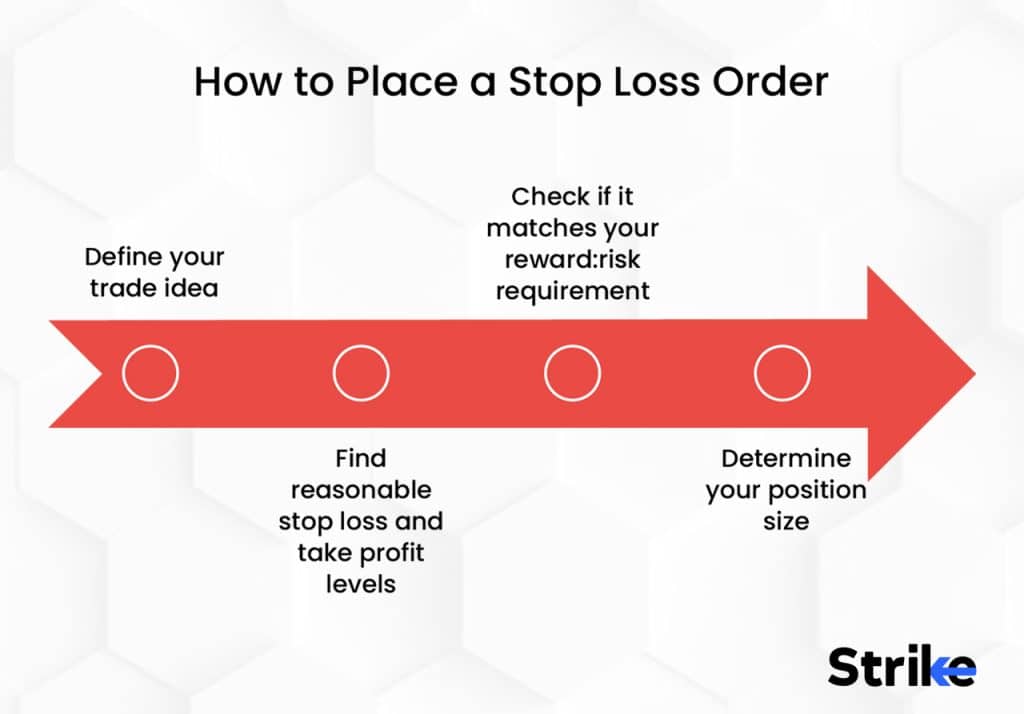
For options buyers, a stop-loss order typically involves placing a stop-limit sell order below the purchased option’s current market price. A market sell order is triggered to close the position If the option’s ask price trades down and touches the stop price. For options sellers, a stop-buy order can be placed above the option’s current market bid to avoid further losses if the contract appreciates suddenly.
Stop levels are typically set below the original purchase price or above the initial sold price to lock in some profits or limit losses to acceptable levels. Wider stops allow more leeway for normal price fluctuations. Tighter stops provide less wiggle room but exit trades quicker when adverse moves hit. In fast-moving markets, stop-loss orders are especially essential for active traders managing multiple open positions across diverse underlying. Automatically closing out losing options helps control portfolio risk and frees up capital to redeploy in more profitable trades.
Gap moves beyond stop levels can occur before orders are triggered when volatility spikes. This slippage risk are mitigated using stop-limit orders which only trigger within predefined limits. Options traders also utilize trailing stops that follow favourable moves to lock in gains.
For example, an Indian trader buys Infosys Rs 1500 call options for Rs 50 each. To limit a loss to Rs 20 per contract, they place a stop-sell order at Rs 30 on the calls. If the calls fall to Rs 30, the stop order is triggered, closing the trade and preventing further downside beyond the defined Rs 20 loss point.
19. In-The-Money (IITM)
In-the-money (ITM) refers to an options contract that has built-in intrinsic value because the strike price is favourable relative to the current trading price of the underlying asset. ITM for call option means the strike is below the market price. For put options, it means the strike exceeds the market price.
An in-the-money options contract already has profits locked in based on the spread between its fixed strike price and the variable market price. Exercising an ITM option before expiration allows capturing this guaranteed intrinsic value.
For example, consider a Reliance Rs 2000 call option when Reliance shares are at Rs 2050. This call is Rs 50 ITM since the right to buy shares at Rs 2000 is inherently worth Rs 50 when they can immediately be sold at Rs 2050. A Rs 1950 put on the same stock would also be Rs 50 ITM.
The deeper an option moves into the money, the higher its intrinsic value. Time value also increases up to a certain optimal point as the option becomes more likely to expire worth exercisable intrinsic value. Deep ITM options have the most premium tied to intrinsic rather than time value. Traders look for ITM options that are still relatively cheap compared to potential further gains. For example, choosing strikes 5-10% ITM can offer leveraged upside exposure with lower premium costs than at-the-money options. Payoffs are limited however since profits are capped beyond the strike.
Rolling ITM options forward involves closing out soon-to-expire positions with remaining time value and opening new contracts at favorable strikes to maintain leverage. Adjusting strikes higher/lower while ITM allows benefiting from ongoing price momentum. Traders also purchase ITM options as stock substitutes when wanting leveraged exposure without the full capital outlay of buying shares outright. Downside is limited to the premium paid while profits can multiply if the stock continues trending favorably. Portfolio margin accounts can further enhance leverage.
For example, instead of buying Rs 2 lakh worth of Infosys shares, an Indian trader buys Rs 200,000 worth of Infosys calls 5% ITM for half the capital with similar upside if the stock rises. The estimated intrinsic value at purchase helps offset premium risk.
20. Out-Of-The-Money (OTM)
Out-of-the-money (OTM) refers to an options contract with a strike price that is unfavorable relative to the current market price of the underlying asset. OTM options have no intrinsic value, only time value based on the probability they move into profitability before expiration.
For call options, OTM means the strike price is higher than the market price of the underlying. For put options, OTM means the strike is lower than the market price at the current time. With no built-in intrinsic value, the entire premium of an OTM option consists of time value that decays over the life of the contract.
Traders look to buy OTM options when they expect wider price moves in the underlying that could turn these contracts profitable. More extreme OTM options far above or below the money have lower premium costs but require larger directional moves. Moderately OTM options offer better leverage on smaller moves with higher profit odds.
OTM options can see disproportionately larger gains versus at- or in-the-money options on the same underlying when volatility is high. This leveraged exposure to volatility is a key driver of OTM popularity. The limited downside of premium paid also makes leveraged OTM options attractive versus owning stock outright.
Selling or writing OTM options generates income from premium collection and has defined risk. With the options starting OTM, the odds of crossing into the money and assignment are lower. Common strategies include covered calls writing OTM against long stock and cash-secured puts for bearish positions.
The flexibility of defining risk-reward profiles by distance OTM makes these options ideal for range-bound trading. For example, an iron condor strategy profits from low volatility using a combination of OTM put and call credit spreads at different strikes.
Traders use OTM options to speculate around events like elections, interest rate decisions or earnings reports. For example, buying far OTM Nifty call options anticipates a significant upside breakout while limiting downside to small premium paid if the view is wrong.
21. At-The-Money (ATM)
At-the-money (ATM) refers to an options contract with a strike price that is equal or close to the current trading price of the underlying security. ATM options have little to no intrinsic value and mostly time value. Specifically, call options are ATM when their strike price is in close proximity to the market price of the stock, index, ETF or other underlying asset. Put options are considered ATM when their strike aligns closely with the current market value.
ATM options offer unique properties that make them widely traded and useful for many strategies. They are more responsive to underlying price changes compared to in- or out-of-the-money options. A small move in the underlying can quickly flip an ATM option from having no intrinsic value to having some.
Their “delta”, which measures an option’s price sensitivity, approaches 0.50 around the money. This balanced risk-reward profile appeals to traders. They exhibit the highest time value compared to in- or out-of-the-money alternatives, benefiting from volatility exposure. Liquidity concentrates near the money, providing favorable bid-ask spreads and easy order execution.
ATM options are preferable to deeper ITM or OTM alternatives when a trader expects moderate movement in either direction and wants to maximize time value exposure. Key strategies like straddles, strangles and butterflies center around long positions in ATM options.
The heightened time value can create cheap ATM option trading opportunities with limited downside when implied volatility is high.. Traders look to capitalize on mean reversion in volatile markets by selling overpriced ATM options. Trading ATM options on index benchmarks like Nifty 50 provides an efficient directional play on the broader market when undecided on further upside or downside. Being near the money allows benefiting from moves in either direction.
For example, a trader buys one month ATM call and put options on Reliance Industries to bet on a short-term swing higher or lower. One side of the straddle becomes profitable while the other side expires worthless if the stock makes a large move up or down.
22. Index Options vs. Equity Options
Index options give traders instruments to speculate on or hedge against moves in an overall market index, while equity options offer similar leveraged exposure on individual company stocks. Their differing underlying assets lead to unique risk-reward considerations. Index options cover broad indexes tracking multiple stocks like Nifty 50 or Bank Nifty in India.
Their prices relate directly to the level of the underlying index. Traders use index options to take a directional view on the wider market based on macroeconomic factors, political developments, business cycles or sentiment.
Equity options cover individual stocks like Reliance, Infosys or HDFC Bank. Their value is tied to the share price of the specific company. Traders utilize equity options to benefit from or protect against anticipated moves in a stock around events like earnings, analyst ratings changes or corporate actions. Since indexes reflect a diversified basket of securities, index options present lower risk compared to individual stock options. Losses are mitigated by positive performance in other index constituents. Equity options carry higher risk of losses from stock-specific adverse events.
Index options offer exposure to broad market sentiment and volatility. They allow easy diversified plays on the market direction. Equity options provide concentrated exposure to single stock volatility based on company-specific factors. Liquidity and trading activity are higher in index options compared to individual stock options. Index options have lower bid-ask spreads due to diverse market participants. Less liquid small-cap stock options can have wider spreads and higher premium costs.
Given their diversified nature, index options are essential for implementing portfolio or index arbitrage strategies. Collar strategies using index puts and calls allow cheap downside protection. Equity options lend themselves more to stock substitution, sector rotation and other stock picking strategies.
For example, a trader buys Nifty 50 call options to benefit from an improving domestic economy and market upside ahead of elections, without picking individual stocks. Another trader buys Reliance calls anticipating strong retail demand in the festive season for the company specifically.
What is Options Trading?
Options trading is a type of financial trading that involves buying and selling options contracts on underlying securities like stocks, bonds, commodities, currencies, or market indexes. An options contract gives the buyer the right, but not the obligation, to buy or sell the underlying asset at a predetermined price (the strike price) on or before a specified date (the expiration date). The seller (or writer) of the options contract is obligated to fulfill the terms if the buyer chooses to exercise the contract.
There are two main types of options – calls and puts. A call option gives the buyer the right to buy the underlying asset. A put option gives the buyer the right to sell the underlying asset. Options traders speculate on the direction of the underlying asset’s price hoping to profit from favorable price movements.
Options are traded on exchanges like the Chicago Board Options Exchange (CBOE) through a brokerage account. Before trading options, investors must fill out an options agreement and be approved for level 2 or higher options trading permissions. Options trading contains substantial risk and is not suitable for all investors. The complexity of options strategies and factors like time decay can work against novice traders. Extensive research, education, and self-evaluation of your risk tolerance are essential before trading options.
How does Options Trading work?
Options trading revolves around the buying and selling of call and put options contracts. These contracts give buyers the right, but not obligation, to buy or sell an underlying asset at a predetermined strike price prior to or on a specified expiration date. Sellers of options are obligated to fulfill the transaction if the options buyer chooses to exercise their contract. Here is a deeper look at how options trading works:
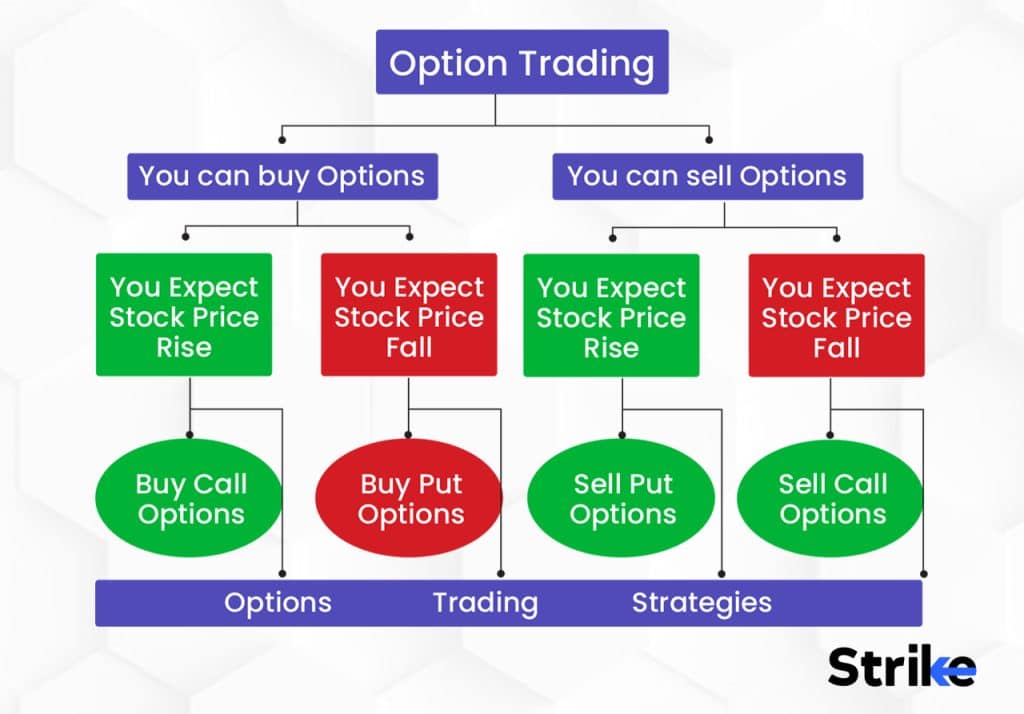
Options contracts specify details like the number of units or shares covered, the type of option (call or put), the expiration date, and the strike price. Options represent 100 shares of the underlying stock by default. The expiration date is the last day an options contract is valid.
The strike price is the price at which the underlying are bought or sold based on the contract terms. Premiums are paid by options buyers and received by sellers. The premium price fluctuates based on factors like the underlying asset price, strike price, time remaining until expiration and implied volatility.
Call option buyers profit when the underlying stock price rises above the strike price before expiration. The higher the stock price, the more intrinsic value the call option holds. Buyers can sell the contract for a profit or exercise the option to buy shares at the lower strike price and then sell at the market price.
Put option buyers profit when the underlying stock price falls below the strike price by expiration. The lower the stock price, the more intrinsic value the put option holds. Put buyers can sell the contract for a profit or exercise the option to sell shares at the higher strike price.
Options sellers profit by collecting premiums paid by options buyers. They keep the premium as long as options expire worthless out of the money. Sellers profit when buyers’ contracts do not reach the strike price by expiration.
Investors trade options through brokerage accounts that give them authorized options trading approval. Brokerages require approval for different options trading levels based on factors like experience, account balances and goals. To buy an options contract, the investor enters an order specifying the underlying asset, type of option, expiration date, strike price and number of contracts.
The order is filled based on availability of existing contracts offered by sellers. Options sold to open a position obligates the seller until the position is closed or expires. Options trades face broker commissions and exchange fees which impact net profits.
What happens during Options Trading?
Options trading involves the buying and selling of options contracts through public exchanges like the Chicago Board Options Exchange (CBOE) and electronically through brokerage firms. There are a series of steps that occur when option trades are executed
Before choosing which options contracts to trade, investors typically spend time analyzing the options marketplace, evaluating potential opportunities, assessing risk/reward scenarios, and determining a trading strategy. Key factors analyzed generally include:
- The underlying stock or asset price and volatility
- Strike prices and expiration dates available
- Premium prices for contracts
- Potential breakeven points
- News and events that impact prices
- Technical indicators signaling trends or price levels
- Overall market conditions and sentiment
Once analysis is complete, the investor chooses the options contract(s) to buy or sell. Specifying details include the below.
- The underlying asset
- Type of option (call or put)
- Contract expiration month/year
- Strike price
- Number of contracts
The investor evaluates potential profits at different price points as well as the maximum loss, which is limited to the premium paid for options bought.
The investor places the options trade through their brokerage account online or over the phone. Order details include the underlying asset, option type, expiration date, strike price, number of contracts and whether the order is a buy or sell order. Additional details like order type, price limits and duration is also specified.
Once received, the brokerage sends the order to the exchange where it is matched and filled based on existing supply and demand. Contracts are transferred from an existing seller. If selling options, the investor is obligated as the new seller. Executed trades are confirmed back to the investor. Unfilled orders are left open until canceled by the investor or expiration is reached.
After execution, the options contracts show up in the investor’s account. For options bought, the total premium cost is deducted from the account balance. For options sold, the premium received is added to the balance. Open options positions will show up in the account until closed or expired.
As the options contracts move closer to expiration, the investor monitors the price movements of the underlying asset and take additional actions.
- For options bought, the investor tracks if the asset price moves toward or away from the breakeven point. They sell the contract early for a profit or loss depending on price direction.
- For options sold, the investor buys contracts to close the position early and take profits or losses.
- New options are bought or sold to adjust a position or hedge risks.
As expiration approaches, the investor decides whether to exercise options bought or have options sold to them exercised. Options in the money at expiration are automatically exercised. The investor receives shares of the stock or cash reflecting the difference between the option strike price and market price. Out of the money options at expiration become worthless and expire.
What are examples of Options Trading?
Let us consider the examples of options trading.
1. Buying Call Options on Reliance Industries: An investor believes Reliance Industries stock will rise over the next 3 months. They buy 10 call option contracts with a strike price of ₹2,000 expiring in January for a premium of ₹100 per share. This gives them the right to buy RIL shares at ₹2,000 anytime until January expiration. RIL stock rises to ₹2,200 by expiration meansthe calls allow buying shares at ₹2,000 instead of the higher market price. The investor can sell the calls for a profit or exercise the options.
2. Selling Put Options on ICICI Bank: An investor sells 10 put option contracts on ICICI Bank with a ₹500 strike price expiring in April for a premium of ₹20 per share. By selling puts, they obligate themselves to buy ICICI stock at ₹500 if the options are exercised. IICICI stock stays above ₹500 through April expiration meansthe puts expire worthless and the investor keeps the ₹20 per share premium as profit.The stock falling below ₹500 means the investor is assigned and have to buy shares at ₹500.
3. Call Debit Spread on Tata Motors: An investor buys a Tata Motors call option with a ₹400 strike and sells a call with a ₹450 strike, both expiring in March. This call debit spread caps upside profit potential but costs less upfront than buying just the ₹400 call outright. Tata Motors trades above ₹450 at expiration means the long ₹400 call offsets the short ₹450 call. Below ₹400, both calls expire worthless. Between ₹400 and ₹450, the spread profits.
These demonstrate basic options trading strategies like buying calls, selling puts, and using spreads. Traders utilize different options combinations to speculate on stock directions or hedge risks on the NSE and BSE in India. The examples exhibit how options can potentially profit from favorable price moves.
What are the different Options Trading Strategies?
Below are five common option trading strategies
1. Long Calls: Buying call options on a stock with the expectation the underlying stock price will increase allows traders to profit from upside moves. This strategy offers limited risk and unlimited profit potential. Maximum loss is limited to the premium paid for the options if the stock fails to reach the strike price.
2. Long Puts: Buying put options allows traders to profit when the underlying stock price decreases. Buying puts is used as a hedge against losses in a portfolio. Maximum loss is limited to the put premium paid if the stock does not fall below the strike price.
3. Covered Calls: Writing or selling call options against shares of stock already owned. This generates income from options premiums to offset some downside risk. Traders keep the premium if stock remains below strike at expiration. Potential for profit is capped at the strike price if exercised.
4. Protective Puts: Buying put options as insurance on a long stock position protects against downside moves. Puts increase in value to offset stock losses. Maximum loss is still limited even if stock falls.
5. Spreads: Using two or more option contracts together in a strategy. Vertical spreads like bull call spreads and bear put spreads limit potential profits but have lower costs. Ratio spreads use differing numbers of buys/sells. Calendar spreads use different expiration dates.
Other common strategies are straddles, strangles, butterflies, condors, collars, and iron condors. These allow traders to benefit from volatility, limit risks, generate income, and speculate on price direction. The variety of options strategies gives traders flexibility.
Is Technical Analysis Needed for Options Trading?
Yes, technical analysis provides important data to complement fundamental analysis. The price trends, volatility measurements, volume metrics, and pattern recognition it provides are extremely helpful for gaining an edge in options trading. Technical and chart analysis are widely used and considered very valuable for trading options successfully.
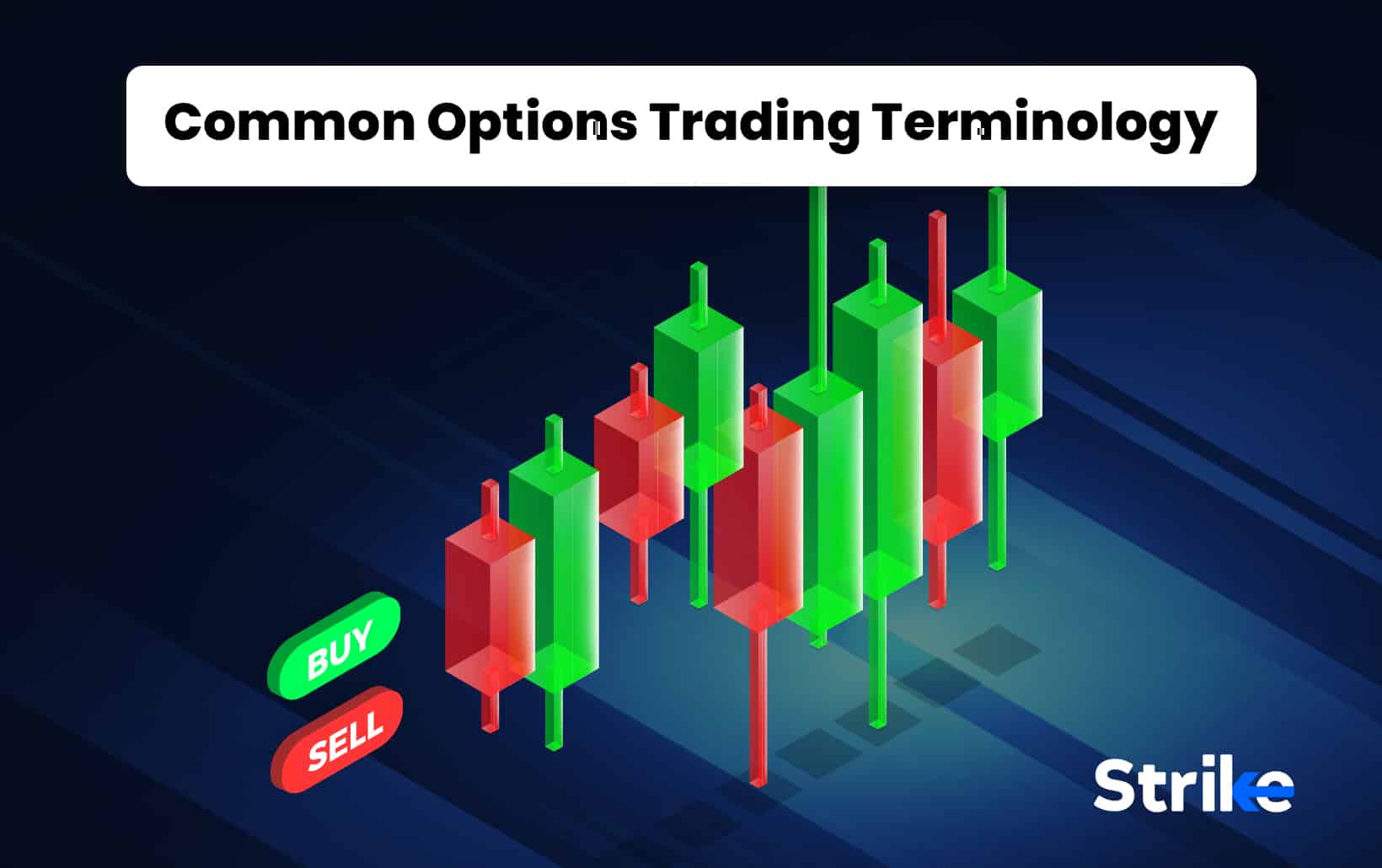





 Previous Article
Previous Article






No Comments Yet